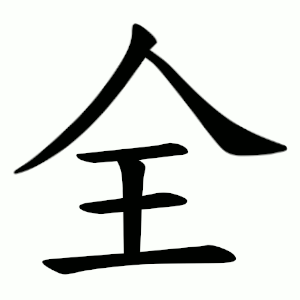全
- whole, complete, entire;
Etymology
Usage in Korean
全國 (전국) – nationwide;
安全 (안전) – safety, security;
全力 (전력) – all one’s strength.
Words that derived from 全
- 안전(安全)–safety
- 안전 보장(安全保障)–security; security assurance
- 안전벨트(安全belt)–safety belt
- 완전(完全)–completeness
- 완전히(完全히)–completely; perfectly
- 전(全)–all
- 전국(全國)–the entire nation
- 전능(全能)–omnipotence
- 전도(全圖)–full map
- 전라남도(全羅南道)–Jeollanam-do Province
- 전문(全文)–the whole text
- 전반(全般)–whole
- 전성(全盛)–being in one's prime years
- 전성기(全盛期)–prime years
- 전성시대(全盛時代)–prime years
- 전역(全域)–entire region
- 전주(全州)–Jeonju
- 전체(全體)–whole
- 전체주의(全體主義)–totalitarianism
- 전편(全篇)–whole
- 전혀(全혀)–(not) at all; completely
全
온전할
전
onjeonhal
jeon
Kangxi radical:11, 入 + 4
Strokes:6
Unicode:U+5168
Cangjie input:
- 人一土 (OMG)
Composition:
- ⿱ 人 王 (G J V)
- ⿱ 入 王 (H T K)
